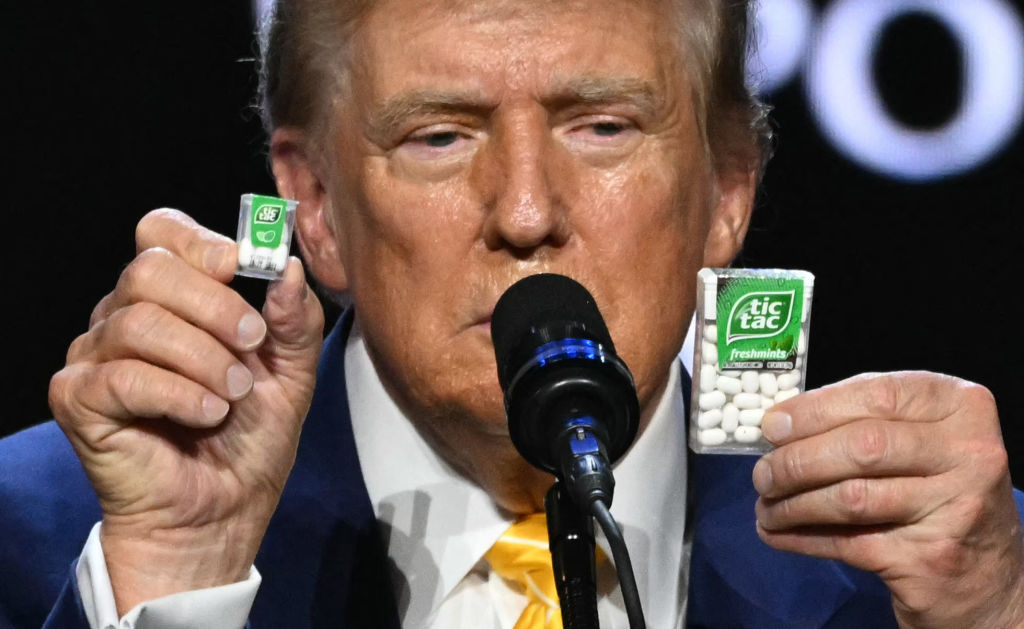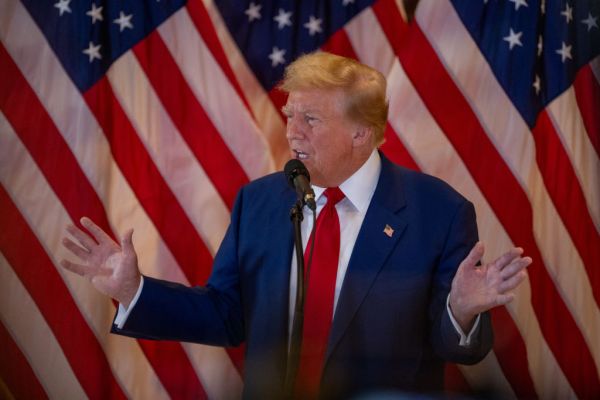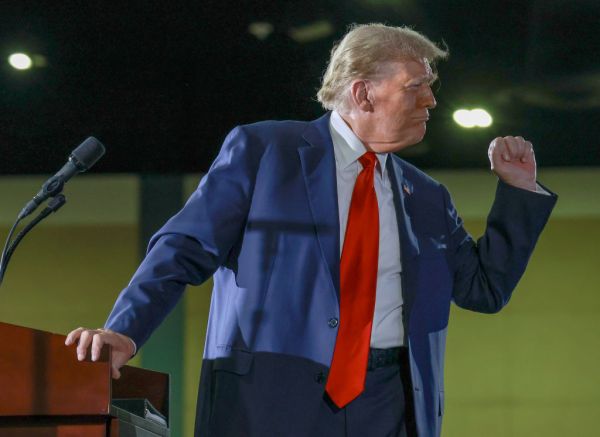President Joe Biden and former President Donald Trump head into this week’s first presidential debate with polls showing a virtual dead heat. The election is likely to turn on economic issues, with voters expressing serious concerns over persistent inflation, rising interest rates, and budget deficits rising to nearly $2 trillion. Moreover, whoever is president next year will inherit far-reaching economic questions: whether to extend the expiring discretionary spending caps, 2021 infrastructure law, and the 2017 tax cuts; how to handle another debt limit fight; and what to do about Social Security’s trust fund standing less than a decade away from insolvency and an automatic 21 percent benefit cut.
Unfortunately, neither Biden nor Trump is offering plausible, pro-growth, or realistic solutions on any of these issues. And in fact, Trump has suggested economic policies that—if he is serious about implementing them—would be extraordinarily damaging to the economy.
Difficult Challenges Await
Assessing the economic proposals of Biden and Trump brings unique challenges. On the positive side, this is a rare election in which both candidates already have a full presidential record of economic policies with which to judge their vision, policies, and performance. On the negative side, neither candidate is focusing his 2024 presidential campaign on economic policy (or really any policy substance whatsoever), or offering a traditional set of detailed proposals. Analyzing Trump’s economic policy platform is further complicated by his campaign offering a “policy agenda” that consists largely of off-the-cuff (and often incoherent and contradictory) candidate comments and leaked statements from private meetings. Thus, it is unclear which policy pronouncements reflect legitimate proposals versus mere candidate spitballing.
Simply comparing macroeconomic variables—such as inflation, economic growth, job growth, interest rates and budget deficits—across each presidency is not particularly revealing. Biden and Trump inherited wildly divergent economies and dealt with unique economic challenges. Trump entered office with an economy that was in the late stages of an economic expansion, enjoying healthy growth and low inflation. This economy nonetheless exceeded most economist expectations between 2017 and 2019 (thanks in part to expensive fiscal stimulus) before the 2020 pandemic closed much of the economy. Overall, Trump signed legislation and executive orders adding $7.8 trillion to 10-year deficits, only half of which was related to the pandemic.
Biden, on the other hand, inherited an economy that was beginning to reopen following a historic pandemic closure. This meant that even baseline economic policies were expected to produce both rapid job growth and a modest degree of inflation: The previous stimulus bills fed demand while supply chain and employment limitations constrained supply. Biden has already signed legislation and executive orders adding $4.3 trillion to 10-year deficits, which would have approached $5 trillion had the Supreme Court not blocked the attempted broad student loan bailout. These spending expansions likely helped accelerate the jobs recovery, but at the cost of further accelerating inflation by 3 percentage points and pushing up interest rates.
Not only did each president serve in a unique economic situation, but this year’s winner will inherit a unique situation in 2025, which will see the scheduled expiration of the 2017 tax cuts, 2023 discretionary spending caps, and 2021 infrastructure bill, as well as the scheduled reimposition of the debt limit. Inflation is now a larger and more persistent problem, and interest rates remain elevated. Budget deficits have skyrocketed, and Social Security is headed toward insolvency. Russian aggression and China’s threatened aggression are placing demands on the world economy and America’s national security priorities. Policies that may have been neutral or slightly harmful in 2017 or 2021 may be extraordinarily destructive to the 2025 economy.
Comparing the Candidates’ Economic Approaches
2017 tax cut expirations: Both Biden and Trump promise to extend the 2017 tax cuts for the 95 percent of taxpayers earning under $400,000 annually, at a cost of roughly $3 trillion over the decade. Trump would also extend the tax cuts for the top-earning 5 percent (raising the cost to nearly $5 trillion) and add other tax cuts such as reducing the corporate tax rate from 21 percent to 20 percent, and exempting tip income from income taxes. Biden pledges to let the 2017 tax cuts expire for the top-earning 5 percent but is likely to call for reimposing the pandemic-era child tax credit level of $3,000 (or $3,600 for children under age 6) at a cost of $1.6 trillion over the decade. He may also accede to congressional Democratic (and some congressional Republican) demands to eliminate the $10,000 cap on state and local tax (SALT) deductions. Ultimately, both candidate price tags in this area will likely well exceed $4 trillion over the decade.
Other spending and tax proposals: President Biden’s latest budget proposal called for $5 trillion in new taxes on upper-earning families and corporations, combined with $2 trillion in new spending expansions (which likely grow past $3 trillion when correcting for the budget’s intentionally lowballed discretionary spending projections). Even a full Democratic Congress is unlikely to approve more than a small fraction of these taxes (just as the Democratic majority in the 117th Congress refused nearly all of Biden tax proposals in 2021 and 2022).* Such aggressive spending hikes would also run into voters’ inflation-weary opposition to more trillion-dollar spending bills. In the absence of a Democratic wave election, Biden will likely be limited to executive orders in areas such as student loans and health care, and a limited number of bipartisan spending expansions in areas such as infrastructure or veterans’ benefits. Trump’s other fiscal policies, meanwhile, are relatively undefined. Blustery comments about impounding (or refusing to spend) legally appropriated funding, terminating the Department of Education, and paying off the Social Security shortfalls with oil and gas revenues would surely run into (respectively) constitutional, political, and mathematical reality. Ukraine aid may be drastically reduced, yet defense and border spending would likely rise as they had in Trump’s previous administration. Tariffs would have a limited revenue effect, as their purpose is to dissuade Americans from purchasing imports (and thus paying the tariff) in the first place.
Most importantly, both Trump and Biden have once again pledged opposition to reforms that would address the Social Security and Medicare cash shortfalls that are projected to rise from $650 billion this year to $2.2 trillion annually within a decade. It is virtually impossible to significantly rein in budget deficits without addressing these primary deficit drivers that are projected to run a total cash shortfall of $124 trillion over three decades (the rest of the federal budget is roughly balanced over those three decades). Even the impending insolvency of the Social Security Trust Fund—which would force an automatic 21 percent benefit cut in just nine years—has not motivated either candidate to discuss solvency reforms. Such delays will likely result in lawmakers bailing out Social Security with deficit spending when the trust fund balance hits zero in 2033.
Ultimately, the combination of unreformed Social Security and Medicare shortfalls, soaring interest costs on the federal debt, and expensive tax cut extensions will likely push annual budget deficits to more than $4 trillion a decade from now under either the Trump or Biden fiscal visions.
Immigration: Trump has pledged to deport illegal immigrants living in the U.S., as well as to dramatically tighten enforcement on the southern border, including finishing the border wall and turning back asylum seekers. While both mass deportations and finishing the wall are extraordinarily unlikely to occur (Trump’s first term mostly fortified the 600 miles with pre-existing border barriers, leaving 1,300 miles without walls), Trump’s policies would likely significantly limit new illegal entries from the southern border.
Biden has also endorsed tougher border policies, although the current surge in border crossings suggests that such policy pronouncements are more rhetorical than serious. Biden has also endorsed pathways to citizenship for many illegal immigrants currently living in the U.S.
Setting aside the broader values and concerns that shape the immigration debate, elevated immigration levels are generally considered a net positive for both the economy and the federal budget. The native (non-immigrant) population is growing just 0.2 percent annually and is projected by the Congressional Budget Office to begin declining within 16 years, with serious negative economic ramifications. Thus, Biden’s more pro-immigration approach is likely to bring more economic growth and slightly smaller short-term deficits, while Trump’s (quite unlikely) mass deportations would almost certainly create worker shortages, economic dislocations, reduced tax revenues, and considerably slower economic growth.
Regulations: Biden has implemented a historic surge in regulations, dwarfing not only the total regulatory burden imposed by President Trump but even that imposed by President Barack Obama. Many of Biden’s most expensive regulations have come from energy- and climate-related red tape, as well as broader economic and business regulations. Biden’s aggressive embrace of unions and industrial policy has also included inflationary regulations such as tightening both “Buy American” rules and Davis-Bacon prevailing wage mandates that raise the labor cost of federal construction projects Even a semiconductor bill that was supposed to reduce production costs instead hit producers with expensive child care and wage mandates that raised costs and prices. While all regulations are meant to accomplish some important goal, the overall economic effect of exorbitant regulation is typically higher prices, elevated business costs, and reduced economic growth.
Trump, on the other hand, has shown a much lighter regulatory touch. Trump’s calls to remove federal civil service protections for many federal workers—if enacted—may also notably tighten his grip on regulatory agencies.
Trade: Trump—who imposed $74 billion of tariffs on steel, aluminum, washing machines, solar panels, and related goods while president—has centered his economic agenda on launching a global trade war. He would impose a global tariff of 10 percent, as well as a tariff as high as 60 percent on Chinese imports. Trump has even floated replacing the entire individual income tax with tariffs—an economic and mathematical impossibility, as consumers’ refusal to purchase most exorbitantly high-tariff items would mean little to no tariff revenue (this is the same Laffer Curve principle that conservatives cite regularly on income taxes). Such tariffs would dramatically raise prices on a broad range of imported items including gasoline, fruit and vegetables, medicine, clothes, electronics, and manufacturing inputs. The cost would most dramatically hit low-income households, who not only spend a larger share of their income than high-earners but also disproportionately spend their money on tariff-drenched items such as food, gas, clothing, and discount goods. Also, tariffs shield American producers from foreign competition, allowing these American companies to significantly hike their own prices and fatten their own profits at the expense of consumers. Finally, tariffs would trigger retaliatory trade restrictions from most of the world, devastating America’s export-driven industries such as agriculture and technology.
Overall, the Tax Foundation estimates that “Trump’s proposal of a 10 percent trade tax matched with in-kind retaliation would shrink the U.S. economy by 1.1 percent and threaten more than 825,000 U.S. jobs.” Tariff revenues would be modest—as consumers dramatically pull back on import purchases—and even those tariff revenues would likely be lost to the resulting economic contraction and the expected subsidies to prop up the devastated export industries.
Nor is President Biden a free trader. He maintained and even expanded most of the inherited Trump tariffs, and is considering a few additional targeted tariffs. Although these trade restrictions have raised prices, cost jobs, and trimmed economic growth, such harm is magnitudes smaller than under Trump’s planned trade war.
Impact on Inflation and the Broader Economy
Both candidates are proposing economic policies that would worsen inflation, damage economic growth, and push annual budget deficits toward $4 trillion. Inflation would likely be driven upward by both candidates’ aggressively expansionary fiscal policies. This inflation would then be either modestly worsened by Biden’s regulatory policies, or dramatically worsened by Trump’s trade war. Such inflation and surging federal debt would also continue to hike interest rates, including mortgage rates.
On broader economic growth, Trump’s trade war and threats of mass deportations could—depending on how aggressively implemented—drive the economy into recession, even despite regulatory policies that are less economically damaging than those of Biden. Trump and Biden would each likely sign tax bills costing roughly $4 trillion over the decade (with somewhat different provisions), expand spending (the magnitude of which would be determined by congressional control and any emergencies or recessions), ignore Social Security and Medicare’s escalating shortfalls, and move Washington closer to a debt crisis.
Voters are used to their presidential choices presenting a lose/lose proposition on economic policy. This year—with underwhelming past presidential records combined with irresponsible and pandering policy proposals—the economic choice is the worst in memory.
Correction, June 26, 2024: This article originally misstated the years of the 117th Congress.






Please note that we at The Dispatch hold ourselves, our work, and our commenters to a higher standard than other places on the internet. We welcome comments that foster genuine debate or discussion—including comments critical of us or our work—but responses that include ad hominem attacks on fellow Dispatch members or are intended to stoke fear and anger may be moderated.
With your membership, you only have the ability to comment on The Morning Dispatch articles. Consider upgrading to join the conversation everywhere.